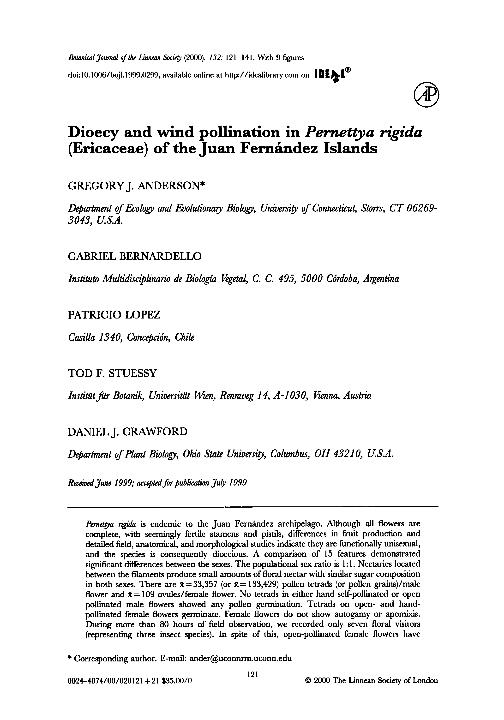Mostrar el registro sencillo del ítem
dc.contributor.author
Anderson, Gregory J.
dc.contributor.author
Bernardello, Gabriel Luis Mario

dc.contributor.author
Lopez , Patricio
dc.contributor.author
Stuessy, Todd F.
dc.contributor.author
Crawford, Daniel
dc.date.available
2018-01-24T15:49:58Z
dc.date.issued
2000-01
dc.identifier.citation
Anderson, Gregory J.; Bernardello, Gabriel Luis Mario; Lopez , Patricio; Stuessy, Todd F.; Crawford, Daniel; Dioecy and wind pollination in Pernettya rigida (Ericaceae) of the Juan Fernández Islands; Wiley Blackwell Publishing, Inc; Botanical Journal of The Linnean Society; 132; 2; 1-2000; 121-141
dc.identifier.issn
0024-4074
dc.identifier.uri
http://hdl.handle.net/11336/34396
dc.description.abstract
Pernettya rigida is endemic to the Juan Fernández archipelago. Although all flowers are complete, with seemingly fertile stamens and pistils, differences in fruit production and detailed field, anatomical, and morphological studies indicate they are functionally unisexual, and the species is consequently dioecious. A comparison of 15 features demonstrated significant differences between the sexes. The populational sex ratio is 1:1. Nectaries located between the filaments produce small amounts of floral nectar with similar sugar composition in both sexes. There are x=33,357 (or x=133,429) pollen tetrads (or pollen grains)/male flower and x=109 ovules/female flower. No tetrads in either hand self-pollinated or open pollinated male flowers showed any pollen germination. Tetrads on open- and hand-pollinated female flowers germinate. Female flowers do not show autogamy or apomixis. During more than 80 hours of field observation, we recorded only seven floral visitors (representing three insect species). In spite of this, open-pollinated female flowers have abundant fruit and seed-set. Thus, we conclude that pollen is transferred abiotically and the ever-present wind over the exposed ridges of the islands is the likely dispersal agent. A number of anemophilous features, such as dry pollen and exposed habitat, support this conclusion. Thus, dioecy and anemophily have evolved independently, in situ, in this species in this remote locality. Preservation of habitat and elimination of competitive invasives are the primary conservation challenges.
dc.format
application/pdf
dc.language.iso
eng
dc.publisher
Wiley Blackwell Publishing, Inc

dc.rights
info:eu-repo/semantics/openAccess
dc.rights.uri
https://creativecommons.org/licenses/by-nc-sa/2.5/ar/
dc.subject
Breeding System
dc.subject
Floral Morphology
dc.subject
Insect Pollination
dc.subject.classification
Otras Ciencias Biológicas

dc.subject.classification
Ciencias Biológicas

dc.subject.classification
CIENCIAS NATURALES Y EXACTAS

dc.title
Dioecy and wind pollination in Pernettya rigida (Ericaceae) of the Juan Fernández Islands
dc.type
info:eu-repo/semantics/article
dc.type
info:ar-repo/semantics/artículo
dc.type
info:eu-repo/semantics/publishedVersion
dc.date.updated
2018-01-24T14:30:42Z
dc.identifier.eissn
1095-8339
dc.journal.volume
132
dc.journal.number
2
dc.journal.pagination
121-141
dc.journal.pais
Reino Unido

dc.description.fil
Fil: Anderson, Gregory J.. University of Connecticut; Estados Unidos
dc.description.fil
Fil: Bernardello, Gabriel Luis Mario. Consejo Nacional de Investigaciones Científicas y Técnicas. Centro Científico Tecnológico Conicet - Córdoba. Instituto Multidisciplinario de Biología Vegetal. Universidad Nacional de Córdoba. Facultad de Ciencias Exactas Físicas y Naturales. Instituto Multidisciplinario de Biología Vegetal; Argentina
dc.description.fil
Fil: Lopez , Patricio. Concepción; Chile
dc.description.fil
Fil: Stuessy, Todd F.. Universidad de Viena; Austria
dc.description.fil
Fil: Crawford, Daniel. Ohio State University; Estados Unidos
dc.journal.title
Botanical Journal of The Linnean Society

dc.relation.alternativeid
info:eu-repo/semantics/altIdentifier/url/https://www.sciencedirect.com/science/article/pii/S0024407499902991
dc.relation.alternativeid
info:eu-repo/semantics/altIdentifier/doi/https://doi.org/10.1006/bojl.1999.0299
Archivos asociados
